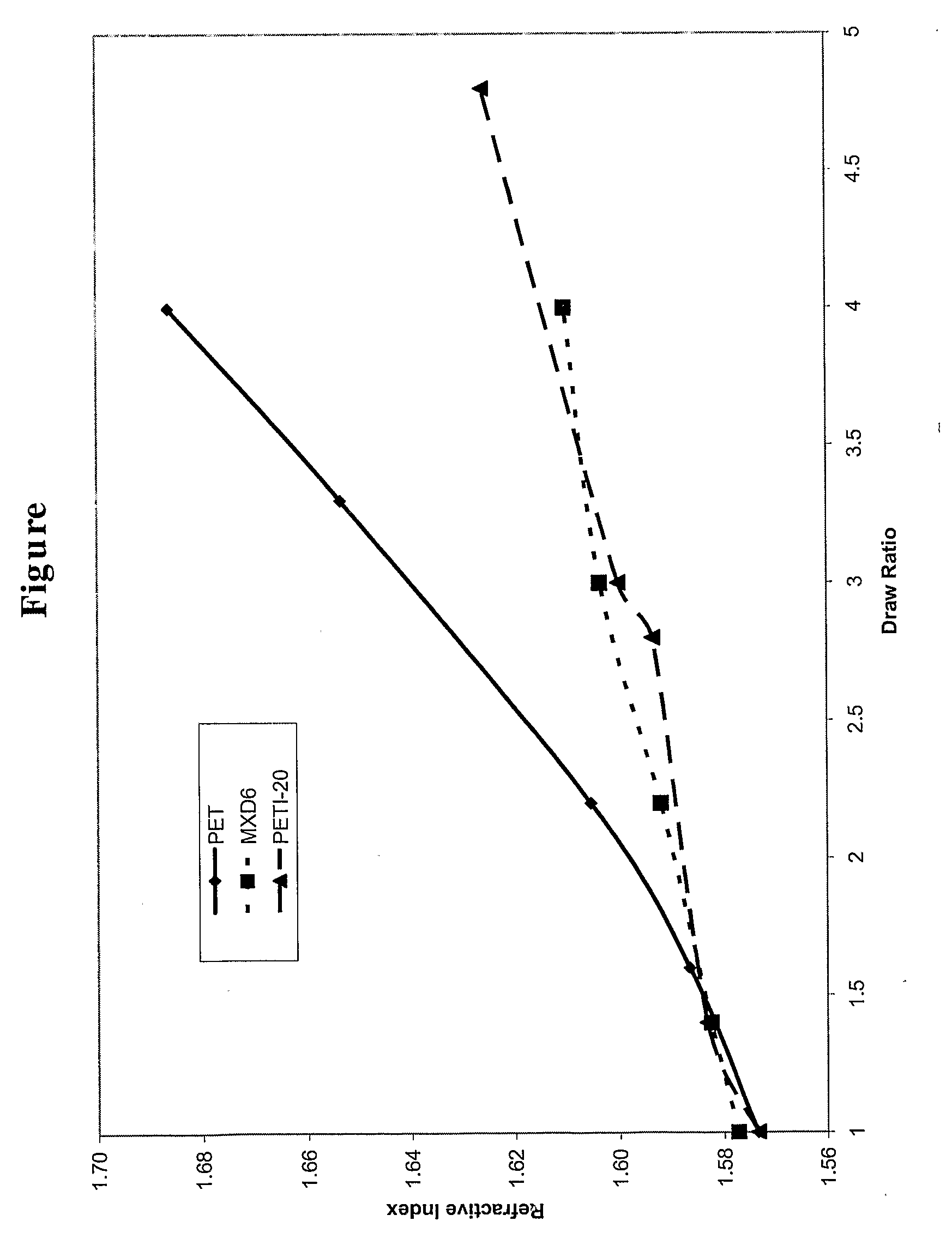Polyester-Polyamide Blends Having Low Haze
a technology of polyamide and polyester, which is applied in the field of polyamide dyes, can solve the problems of reducing the shelf life of carbonated soft drinks and oxygen sensitive materials, reducing the shelf life of oxygen sensitive materials, and reducing the success of polyester dyes. , to achieve the effect of reducing haz
- Summary
- Abstract
- Description
- Claims
- Application Information
AI Technical Summary
Benefits of technology
Problems solved by technology
Method used
Image
Examples
example 1
[0081]Blends of 75 wt-% PET, 15 wt-% PETS and 10 wt-% of different polyamides were prepared. The refractive index and transparency of the isotropic films (0.2 mm thick) are set forth in table 4, and compared to a PET control (100% PET).
TABLE 4ΔRIMaterialsRI(PA-PET)TransparencyPET control1.5735—92MXD6 blend1.57730.0038906I6,9 blend1.5656−0.0079906IT blend1.58640.012986
[0082]The close match of the refractive index of PET and MXD6 resulted in comparable film transparency. Increasing the aromaticity of the polyamide (6IT) increased its refractive index resulting in a loss of transparency.
[0083]These films were uniaxially oriented to a draw ratio of 4×. The transparency was measured in polarized and unpolarized light and the results set forth in Table 5.
TABLE 5Polarized lightUnpolarized light / / orientation⊥ orientationMaterialsT %T %T %PET control898989MXD6 blend6646816I6,9 blend6546786IT blend453458
[0084]Polarized light shows that the loss in orientation was dominantly due to the loss i...
example 2
[0088]Blends of 75 wt-% PET, 15 wt-% PETS and 10 wt-% of MXD6 and MXD6I-12 were prepared. Isotropic, biaxially oriented films and 2 liter bottles prepared. The oxygen permeability at 0% RH was measured and the results set forth in Table 7. The PET control is 100% PET.
TABLE 7O2 Permeability (cc(STP) · cm) / (m2 · atm · day))MaterialIsotropicBiaxially OrientedBottle sidewallPET control0.3630.2530.180MXD6 blend0.2950.0780.063MXD6I-12 blend0.2820.1040.081
[0089]The carbon dioxide permeability at 0% RH for the same film samples was measured and the results set forth in Table 8.
TABLE 8CO2 Permeability (cc(STP) · cm) / (m2 · atm · day))MaterialIsotropicBiaxially OrientedPET control0.3630.253MXD6 blend0.2950.078MXD6I-12 blend0.2820.104
[0090]For both oxygen and carbon dioxide permeability, MXD6 reduced the permeability in the oriented structure more than the MXD6I-12 polyamide.
example 3
[0091]Blends of 75 wt-% PET-co-isophthalate copolyesters, 15 wt-% PETS and 10 wt-% MXD6 were prepared. The refractive index and transparency of the isotropic films (0.2 mm thick) are set forth in table 9. The PET and PEI controls are 100% homopolymers.
TABLE 9Polyester MaterialRefractive IndexTransparency, %PET control1.573592PETI-71.573590PETI-201.573590PETI-301.573590PEI control1.573592
[0092]These films were uniaxially oriented to a draw ratio of 4×. The transparency was measured in polarized and unpolarized light and the results set forth in Table 10. The PET blend is a blend of 75 wt-% PET, 15 wt-% PETS and 10 wt-% MXD6.
TABLE 10Polarized lightUnpolarized light / / orientation⊥ orientationMaterialsT %T %T %PET control898988PET blend664681PETI-7 blend746184PETI-30 blend353535
[0093]The MXD6 domain size in the PETI-7 blend was 0.1-0.3 μm, but the domain size was much larger in the PETI-30 blend due to a lower molecular weight. A similar trend was seen in biaxially oriented films, the r...
PUM
| Property | Measurement | Unit |
|---|---|---|
| refractive index | aaaaa | aaaaa |
| haze | aaaaa | aaaaa |
| haze | aaaaa | aaaaa |
Abstract
Description
Claims
Application Information
 Login to View More
Login to View More - R&D
- Intellectual Property
- Life Sciences
- Materials
- Tech Scout
- Unparalleled Data Quality
- Higher Quality Content
- 60% Fewer Hallucinations
Browse by: Latest US Patents, China's latest patents, Technical Efficacy Thesaurus, Application Domain, Technology Topic, Popular Technical Reports.
© 2025 PatSnap. All rights reserved.Legal|Privacy policy|Modern Slavery Act Transparency Statement|Sitemap|About US| Contact US: help@patsnap.com

